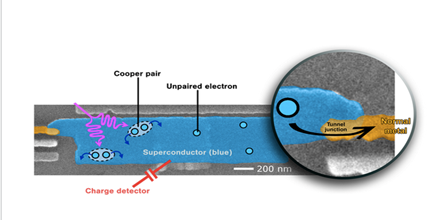Silence Points The Way Towards Better Superconductors
High-precision measurements provide important clues about processes that impair superconductor efficiency. Superconductivity depends on the presence of electrons bound together in a Cooper pair. Two electrons become coupled because of interactions with the metal lattice, synchronizing despite being hundreds of nanometers apart. Below a critical temperature, Cooper pairs act as a fluid, which does not dissipate energy, providing no resistance to electrical current.
When Cooper pairs break, they dissipate into two quasiparticles, unpaired electrons that hamper the performance of superconductors.
Understanding the origin of quasiparticles would be a step towards improving the performance of superconductors. Researchers at Aalto precisely measured the dynamics of Cooper pair breaking in a superconductor.
Together with researchers from Lund University and VTT, the team at Aalto set up an experiment to detect small numbers of quasiparticles in real time. Researchers found that Cooper pairs break in bursts, with long periods of silence interrupted by very short flurries of quasiparticles.
The silent periods were several orders of magnitude longer than the bursts. The superconductor was entirely free of quasiparticles for seconds at a time, which is much longer than required for a qubit operation. The study marks an important step towards building ideally functioning superconducting devices.

